Wind Pressure Coefficient on a Multi-Storey Building with External Shading Louvers
Abstract
:1. Introduction
2. Wind Tunnel Experiment
3. CFD Simulation
3.1. Reference Case
3.1.1. Geometric Model
3.1.2. Turbulence Model
3.1.3. Computational Domain and Grid Resolution
3.1.4. Boundary Conditions
3.1.5. Solver Settings
3.1.6. Calculation of Wind Pressure Coefficient
3.2. Result Validation
4. Results and Discussion
4.1. General Features of Airflow Pattern
4.2. Features of Local Wind Pressure Coefficient along Measurement Lines
4.2.1. Local Wind Pressure Coefficient on W-R-L Lines
4.2.2. Local Wind Pressure Coefficient on W-S-L Lines
4.2.3. Local Wind Pressure Coefficient on R-S Lines
4.3. Impact of Shading Louvers on Average Wind Pressure Coefficient
5. Conclusions
- The validation of the studied building shows a small deviation between the numerical data and the data from the previous study. The average absolute deviation is 0.046 for wind pressure coefficient Cp and 0.068 for normalized velocity U/Uref. The Grid Convergence Index of U/Uref and Cp for the reference case is 0.37%, and 1.8%, respectively. Therefore, the parameters of the simulation cases are feasible for the shaded building, and the computational settings is useful for further case studies of shaded buildings.
- In general, the fluctuations of Cp on the windward and roof surfaces are mostly stronger than those on the lateral and leeward surfaces along the measurement lines. These results indicate that when the ventilation openings located on the roof and windward facade with louvers, the ventilation routes can lead to larger fluctuations of ventilation rate. In building design, it is important to diagnose the risks of inadequate ventilation for shaded buildings, especially those with roof ventilation systems.
- The stagnation zone of the windward surface has the highest average wind pressure coefficient . For most floors and rows, decreases with a higher rotation angle θ. And has the greatest reduction for all floors when θ turns from 60° to 75°. These results indicate that ventilation openings on the stagnation zone contribute to higher ventilation rate for the windward facade with louvers. When the rotation angle is taken for more than 60°, it is essential to avoid bad indoor wind environment for rooms with ventilation openings located on the shaded facade.
Author Contributions
Funding
Conflicts of Interest
Nomenclature
| A | opening area |
| AR | area of the outside surface of a room |
| B | louver width |
| Cd | discharge coefficient |
| Cp | wind pressure coefficient |
| Cp-max | maximum wind pressure coefficient |
| Cp-min | minimum wind pressure coefficient |
| Cμ | empirical constant |
| F1, F2, F3, F4, F5 | labels for different floors |
| h0 | reference height (m) |
| i | shaded condition |
| I | turbulent intensity |
| j | building row |
| k | turbulent kinetic energy (m2/s2) |
| P | static pressure |
| Pi | indoor pressure |
| Pref | static pressure at the reference point |
| Q | wind-induced airflow rate (m3/s) |
| R | range of wind pressure coefficient |
| R1, R2, R3, R4, R5, R6, R7 | labels for different rows |
| U | wind velocity (m/s) |
| U(z) | wind velocity at the height z (m/s) |
| Un | normalized velocity |
| Uref | reference velocity |
| W | distance between louvers and the windward facade |
| x, y, z | coordinates |
| y+ | dimensionless wall distance |
| α | coefficient for power-law profile of wind velocity |
| ε | turbulence dissipation rate (m2/s3) |
| θ | rotation angle of external shading louvers (°) |
| ρ | air density |
| ∆SR | area of a grid on the outside surface |
| average wind pressure coefficient | |
| difference of average wind pressure coefficient between a shaded condition and the non-shaded condition | |
| average difference of wind pressure coefficient for all shaded conditions compared with the non-shaded condition in a special row | |
| average difference of wind pressure coefficient between a specific shaded condition and the non-shaded condition in a whole row | |
| average wind pressure coefficient in the non-shaded condition | |
| average wind pressure coefficient in a specific row j | |
| average value of wind pressure coefficient for the shaded condition i with a specific rotation angle θ |
References
- Eom, J.; Clarke, L.E.; Kim, S.H.; Kyle, G.P.; Patel, P.L. China’s Building Energy Use: A Long-Term Perspective Based on a Detailed Assessment; Pacific Northwest National Lab.: Richland, WA, USA, 2012. [Google Scholar]
- Kirimtat, A.; Koyunbaba, B.K.; Chatzikonstantinou, I.; Sariyildiz, S. Review of simulation modeling for shading devices in buildings. Renew. Sustain. Energy Rev. 2016, 53, 23–49. [Google Scholar] [CrossRef]
- Littlefair, P.; Ortiz, J.; Bhaumik, C.D. A simulation of solar shading control on UK office energy use. Build. Res. Inf. 2010, 38, 638–646. [Google Scholar] [CrossRef]
- Liu, M.; Wittchen, K.B.; Heiselberg, P.K. Control strategies for intelligent glazed façade and their influence on energy and comfort performance of office buildings in Denmark. Appl. Energy 2015, 145, 43–51. [Google Scholar] [CrossRef]
- Stazi, F.; Marinelli, S.; Di Perna, C.; Munafò, P. Comparison on solar shadings: Monitoring of the thermo-physical behaviour, assessment of the energy saving, thermal comfort, natural lighting and environmental impact. Sol. Energy 2014, 105, 512–528. [Google Scholar] [CrossRef]
- Tao, Q.H.; Li, Z.; Zheng, J.; Chen, X. Model of solar diffuse radiation transmission through circular perforated louvers and experimental verification. Energy Build. 2017, 142, 49–55. [Google Scholar] [CrossRef]
- Tao, Q.H.; Li, Z.; Zheng, J.; Jiang, F. A mathematical model for calculating total transmission of solar radiation through shuttle louvers and experimental verification. Energy Build. 2018, 172, 159–169. [Google Scholar] [CrossRef]
- Konstantzos, I.; Tzempelikos, A.; Chan, Y.C. Experimental and simulation analysis of daylight glare probability in offices with dynamic window shades. Build Environ. 2015, 87, 244–254. [Google Scholar] [CrossRef]
- Tablada, A.; Carmeliet, J.; Baelmans, M.; Saelens, D. Exterior Louvers as a Passive Cooling Strategy in a Residential Building: Computational fluid dynamics and building energy simulation modelling. In Proceedings of the 26th Conference on Passive and Low Energy Architecture, Quebec City, QC, Canada, 22–24 June 2009. [Google Scholar]
- Chandrashekaran, D. Air Flow through Louvered Openings: Effect of Louver Slats on Air Movement inside a Space. Master Thesis, University of Southern California, Los Angeles, CA, USA, 2010. [Google Scholar]
- Sun, N.; Cui, Y.; Jiang, Y. Lighting and Ventilation-based Building Sun-Shading Design and Simulation Case in Cold Regions. Energy Procedia 2018, 152, 462–469. [Google Scholar] [CrossRef]
- Kosutova, K.; van Hooff, T.; Vanderwel, C.; Blocken, B.; Hensen, J. Cross-ventilation in a generic isolated building equipped with louvers: Wind-tunnel experiments and CFD simulations. Build Environ. 2019, 154, 263–280. [Google Scholar] [CrossRef]
- Karava, P.; Stathopoulos, T.; Athienitis, A.K. Wind driven flow through openings–a review of discharge coefficients. Int. J. Vent. 2004, 3, 255–266. [Google Scholar] [CrossRef]
- Larsen, T.S. Natural Ventilation Driven by Wind and Temperature Difference. Ph.D. Thesis, Aalborg University, Aalborg, Denmark, 2006. [Google Scholar]
- Etheridge, D. Natural ventilation of buildings theory measurement and design. Int. J. Vent. 2011, 10, 405–406. [Google Scholar] [CrossRef]
- American Society of Heating, Refrigerating and Air-Conditioning Engineers Inc. ASHRAE Handbook Fundamentals; American Society of Heating, Refrigerating and Air-Conditioning Engineers Inc.: Atlanta, GA, USA, 2013. [Google Scholar]
- Montazeri, H.; Blocken, B. CFD simulation of wind-induced pressure coefficients on buildings with and without balconies: Validation and sensitivity analysis. Build Environ. 2013, 60, 137–149. [Google Scholar] [CrossRef]
- Gullbrekken, L.; Uvsløkk, S.; Kvande, T.; Pettersson, K.; Time, B. Wind pressure coefficients for roof ventilation purposes. J. Wind. Eng. Ind. Aerod. 2018, 175, 144–152. [Google Scholar] [CrossRef]
- Hong, X.; He, W.; Hu, Z.; Wang, C.; Ji, J. Three-dimensional simulation on the thermal performance of a novel Trombe wall with venetian blind structure. Energy Build. 2015, 89, 32–38. [Google Scholar] [CrossRef]
- Zeng, Z.; Li, X.; Li, C.; Zhu, Y. Modeling ventilation in naturally ventilated double-skin façade with a venetian blind. Build Environ. 2012, 57, 1–6. [Google Scholar] [CrossRef]
- Richards, P.J.; Hoxey, R.P.; Short, L.J. Wind pressures on a 6m cube. J. Wind. Eng. Ind. Aerod. 2001, 89, 1553–1564. [Google Scholar] [CrossRef]
- Richards, P.J.; Hoxey, R.P. Pressures on a cubic building—Part 1: Full-scale results. J. Wind. Eng. Ind. Aerod. 2012, 102, 72–86. [Google Scholar] [CrossRef]
- Richardson, G.M.; Surry, D. The Silsoe structures building: Comparison between full-scale and wind-tunnel data. J. Wind. Eng. Ind. Aerod. 1994, 51, 157–176. [Google Scholar] [CrossRef]
- Guan, Y.; Li, A.; Zhang, Y.; Jiang, C.; Wang, Q. Experimental and numerical investigation on the distribution characteristics of wind pressure coefficient of airflow around enclosed and open-window buildings. Build. Simul. 2016, 9, 551–568. [Google Scholar] [CrossRef]
- Yang, L.; Gurley, K.R.; Prevatt, D.O. Probabilistic modeling of wind pressure on low-rise buildings. J. Wind. Eng. Ind. Aerod. 2013, 114, 18–26. [Google Scholar] [CrossRef]
- Gomes, M.G.; Rodrigues, A.M.; Mendes, P. Experimental and numerical study of wind pressures on irregular-plan shapes. J. Wind. Eng. Ind. Aerod. 2005, 93, 741–756. [Google Scholar] [CrossRef]
- Holmes, J.D.; Carpenter, P. The effect of Jensen Number variations on the wind loads on a low-rise building. J. Wind. Eng. Ind. Aerod. 1990, 36, 1279–1288. [Google Scholar] [CrossRef]
- Grosso, M. Wind pressure distribution around buildings: A parametrical model. Energy Build. 1992, 18, 101–131. [Google Scholar] [CrossRef]
- Lou, W.; Huang, M.; Zhang, M.; Lin, N. Experimental and zonal modeling for wind pressures on double-skin facades of a tall building. Energy Build. 2012, 54, 179–191. [Google Scholar] [CrossRef]
- Muehleisen, R.T.; Patrizi, S. A new parametric equation for the wind pressure coefficient for low-rise buildings. Energy Build. 2013, 57, 245–249. [Google Scholar] [CrossRef]
- Shen, X.; Zhang, G.; Bjerg, B. Comparison of different methods for estimating ventilation rates through wind driven ventilated buildings. Energy Build. 2012, 54, 297–306. [Google Scholar] [CrossRef]
- Liu, J.; Niu, J. CFD simulation of the wind environment around an isolated high-rise building: An evaluation of SRANS, LES and DES models. Build Environ. 2016, 96, 91–106. [Google Scholar] [CrossRef]
- Cóstola, D.; Blocken, B.; Hensen, J.L.M. Overview of pressure coefficient data in building energy simulation and airflow network programs. Build Environ. 2009, 44, 2027–2036. [Google Scholar] [CrossRef] [Green Version]
- Ramponi, R.; Blocken, B. CFD simulation of cross-ventilation for a generic isolated building: Impact of computational parameters. Build Environ. 2012, 53, 34–48. [Google Scholar] [CrossRef]
- Kato, S.; Murakami, S.; Mochida, A.; Akabayashi, S.I.; Tominaga, Y. Velocity-pressure field of cross ventilation with open windows analyzed by wind tunnel and numerical simulation. J. Wind. Eng. Ind. Aerod. 1992, 41, 2575–2586. [Google Scholar] [CrossRef]
- Karava, P.; Stathopoulos, T.; Athienitis, A.K. Wind-induced natural ventilation analysis. Sol. Energy 2007, 81, 20–30. [Google Scholar] [CrossRef]
- Liu, X.; Niu, J.; Kwok, K.C.S. Evaluation of RANS turbulence models for simulating wind-induced mean pressures and dispersions around a complex-shaped high-rise building. Build. Simul. 2013, 6, 151–164. [Google Scholar] [CrossRef]
- Ramponi, R.; Angelotti, A.; Blocken, B. Energy saving potential of night ventilation: Sensitivity to pressure coefficients for different European climates. Appl. Energy 2014, 123, 185–195. [Google Scholar] [CrossRef]
- Peng, X.; Yang, L.; Gavanski, E.; Gurley, K.; Prevatt, D. A comparison of methods to estimate peak wind loads on buildings. J. Wind. Eng. Ind. Aerod. 2014, 126, 11–23. [Google Scholar] [CrossRef]
- Kim, G.; Lim, H.S.; Lim, T.S.; Schaefer, L.; Kim, J.T. Comparative advantage of an exterior shading device in thermal performance for residential buildings. Energy Build. 2012, 46, 105–111. [Google Scholar] [CrossRef]
- Cóstola, D.; Blocken, B.; Ohba, M.; Hensen, J.L.M. Uncertainty in airflow rate calculations due to the use of surface-averaged pressure coefficients. Energy Build. 2010, 42, 881–888. [Google Scholar] [CrossRef] [Green Version]
- Mou, B.; He, B.J.; Zhao, D.X.; Chau, K.W. Numerical simulation of the effects of building dimensional variation on wind pressure distribution. Eng. Appl. Comp. Fluid. Mech. 2017, 11, 293–309. [Google Scholar] [CrossRef]
- Cóstola, D.; Blocken, B.; Hensen, J.L.M. Uncertainties due to the use of surface averaged wind pressure coefficients. In Proceedings of the 29th AIVC Conference, Kyoto, Japan, 14–16 October 2008. [Google Scholar]
- Jiang, F.; Li, Z.; Zhao, Q.; Tao, Q.; Yuan, Y.; Lu, S. Flow field around a surface-mounted cubic building with louver blinds. Build. Simul. 2019, 12, 141–151. [Google Scholar] [CrossRef]
- Zheng, J.; Tao, Q.; Li, L. Study of influence of shading louvers on wind characteristics around buildings under different wind directions. In Proceedings of the 4th Asia Conference of International Building Performance Simulation Association, Hong Kong, China, 3–5 December 2018. [Google Scholar]
- Franke, J. Recommendations of the COST action C14 on the use of CFD in predicting pedestrian wind environment. In Proceedings of the Fourth International Symposium on Computational Wind Engineering, Yokohama, Japan, 16–19 July 2006. [Google Scholar]
- Tominaga, Y.; Mochida, A.; Yoshie, R.; Kataoka, H.; Nozu, T.; Yoshikawa, M.; Shirasawa, T. AIJ guidelines for practical applications of CFD to pedestrian wind environment around buildings. J. Wind. Eng. Ind. Aerod. 2008, 96, 1749–1761. [Google Scholar] [CrossRef]
- Versteeg, H.K.; Malalasekera, W. An Introduction to Computational Fluid Dynamics: The Finite Volume Method; Pearson Education: London, UK, 2007. [Google Scholar]
- Toparlar, Y.; Blocken, B.; Maiheu, B.; van Heijst, G.J.F. A review on the CFD analysis of urban microclimate. Renew. Sustain. Energy Rev. 2017, 80, 1613–1640. [Google Scholar] [CrossRef]
- Meng, F.Q.; He, B.J.; Zhu, J.; Zhao, D.X.; Darko, A.; Zhao, Z.Q. Sensitivity analysis of wind pressure coefficients on CAARC standard tall buildings in CFD simulations. J. Build. Eng. 2018, 16, 146–158. [Google Scholar] [CrossRef]
- ANSYS, Inc. ANSYS Fluent Theory Guide; ANSYS, Inc.: Canonsburg, PA, USA, 2013. [Google Scholar]
- Roache, P.J. Perspective: A method for uniform reporting of grid refinement studies. J. Fluid. Eng. 1994, 116, 405–413. [Google Scholar] [CrossRef]
- Roache, P.J. Quantification of uncertainty in computational fluid dynamics. Annu. Rev. Fluid. Mech. 1997, 29, 123–160. [Google Scholar] [CrossRef] [Green Version]
- Vinchurkar, S.; Longest, P.W. Evaluation of hexahedral, prismatic and hybrid mesh styles for simulating respiratory aerosol dynamics. Comput. Fluids 2008, 37, 317–331. [Google Scholar] [CrossRef]
- Blocken, B. Computational fluid dynamics for urban physics: Importance, scales, possibilities, limitations and ten tips and tricks towards accurate and reliable simulations. Build Environ. 2015, 91, 219–245. [Google Scholar] [CrossRef] [Green Version]
- Mochida, A.; Lun, I.Y.F. Prediction of wind environment and thermal comfort at pedestrian level in urban area. J. Wind. Eng. Ind. Aerod. 2008, 96, 1498–1527. [Google Scholar] [CrossRef]
- Shirzadi, M.; Mirzaei, P.A.; Naghashzadegan, M. Improvement of k-epsilon turbulence model for CFD simulation of atmospheric boundary layer around a high-rise building using stochastic optimization and Monte Carlo Sampling technique. J. Wind. Eng. Ind. Aerod. 2017, 171, 366–379. [Google Scholar] [CrossRef]
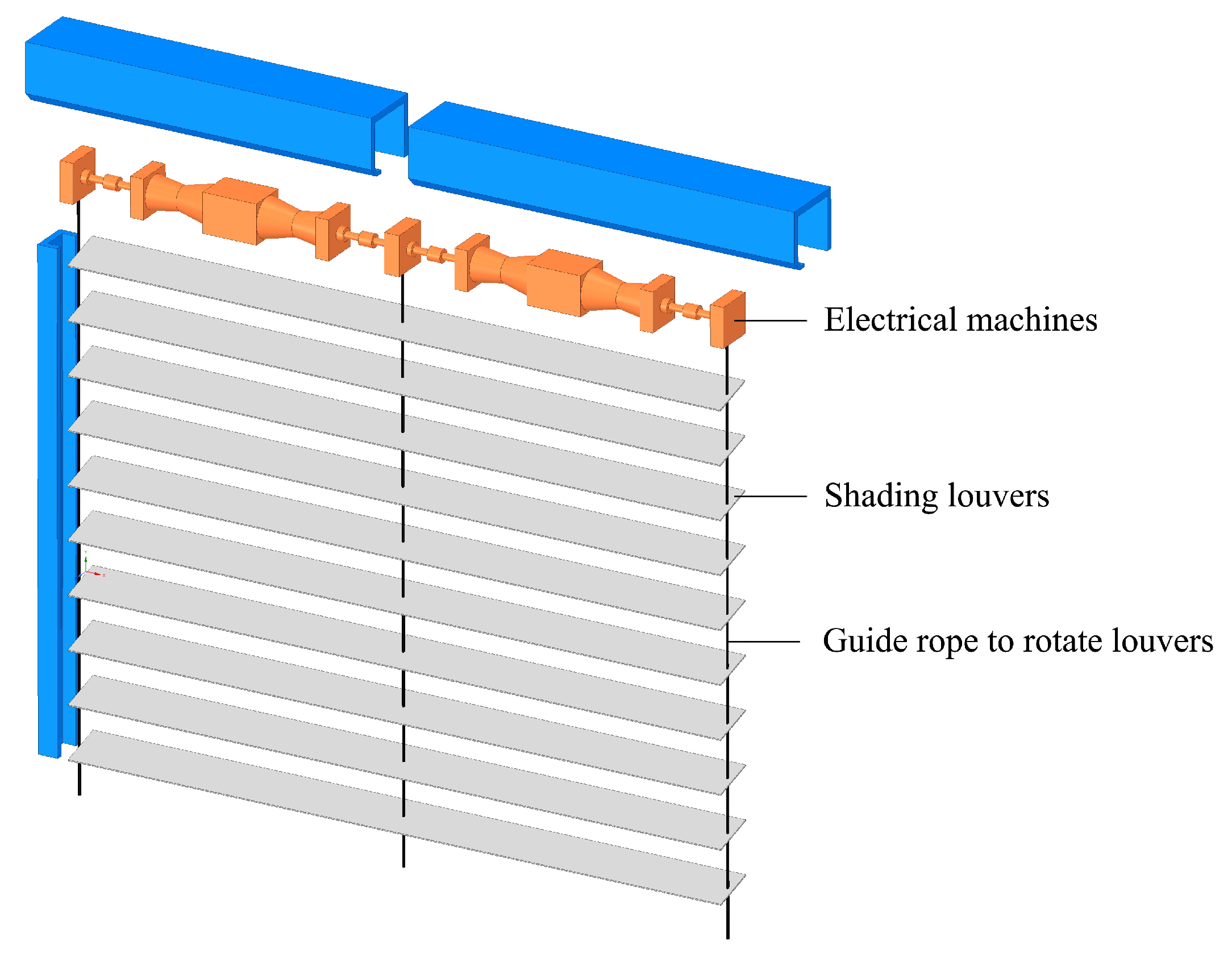
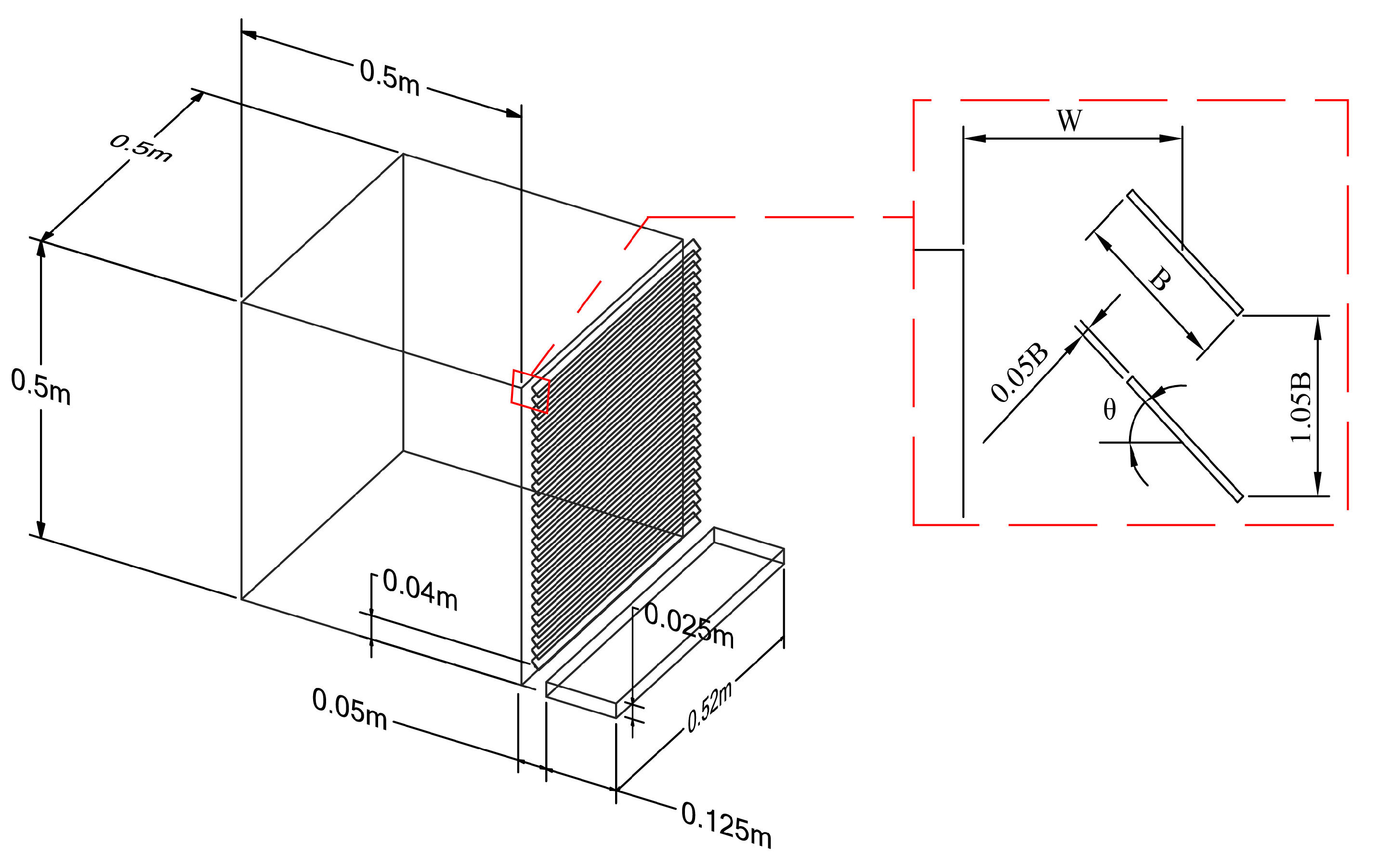
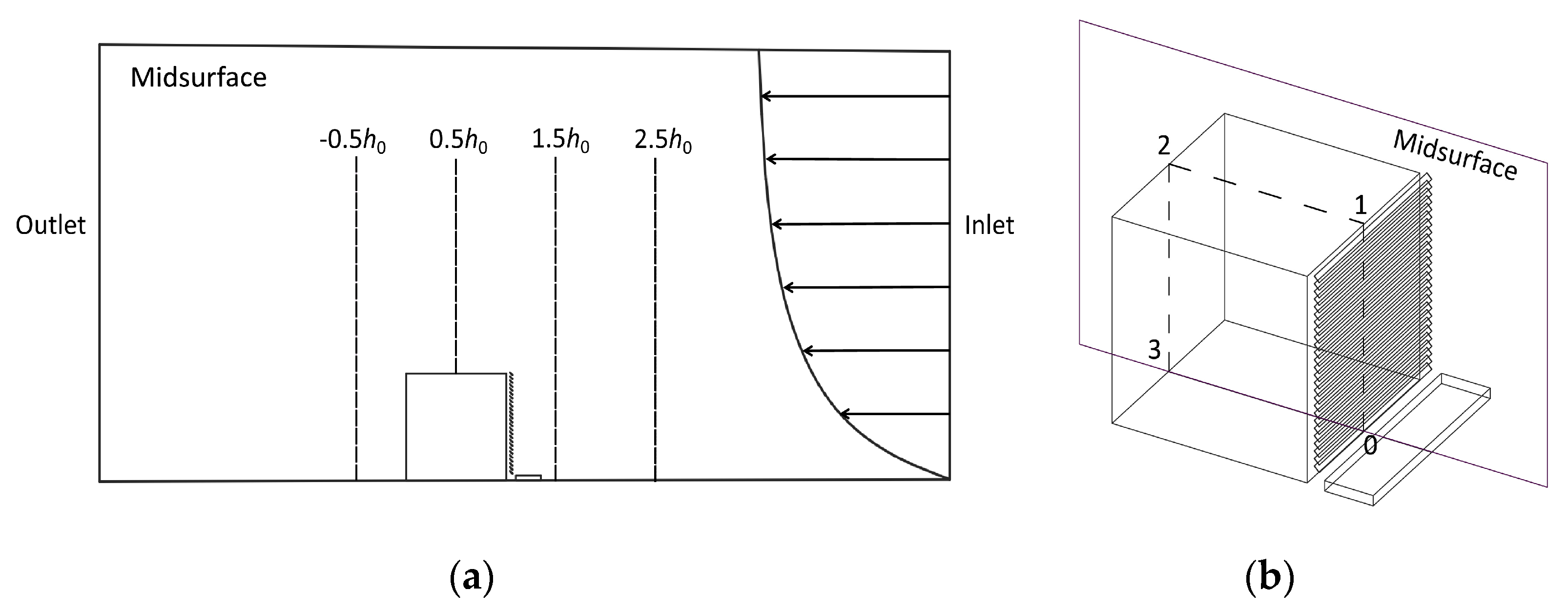

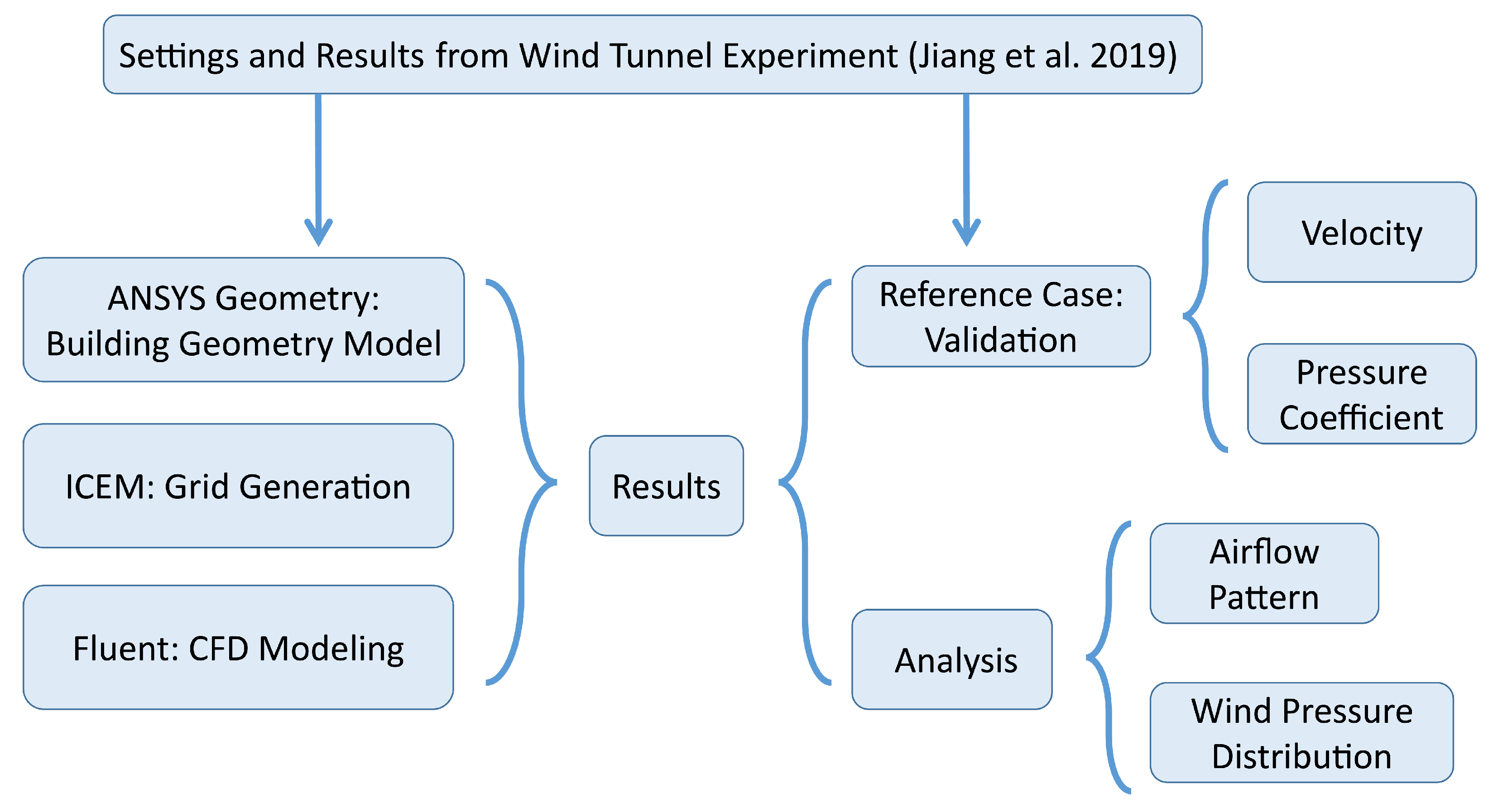
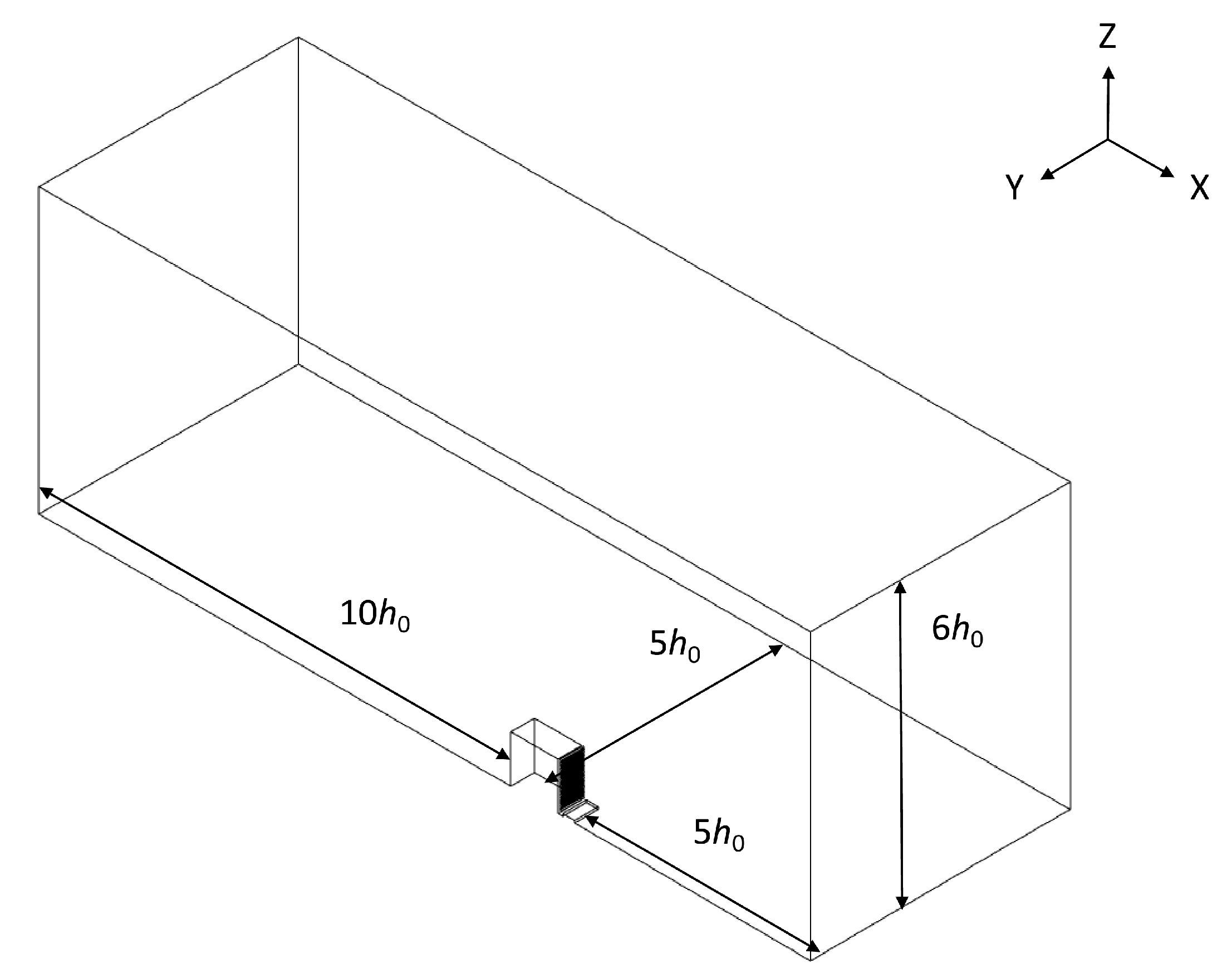
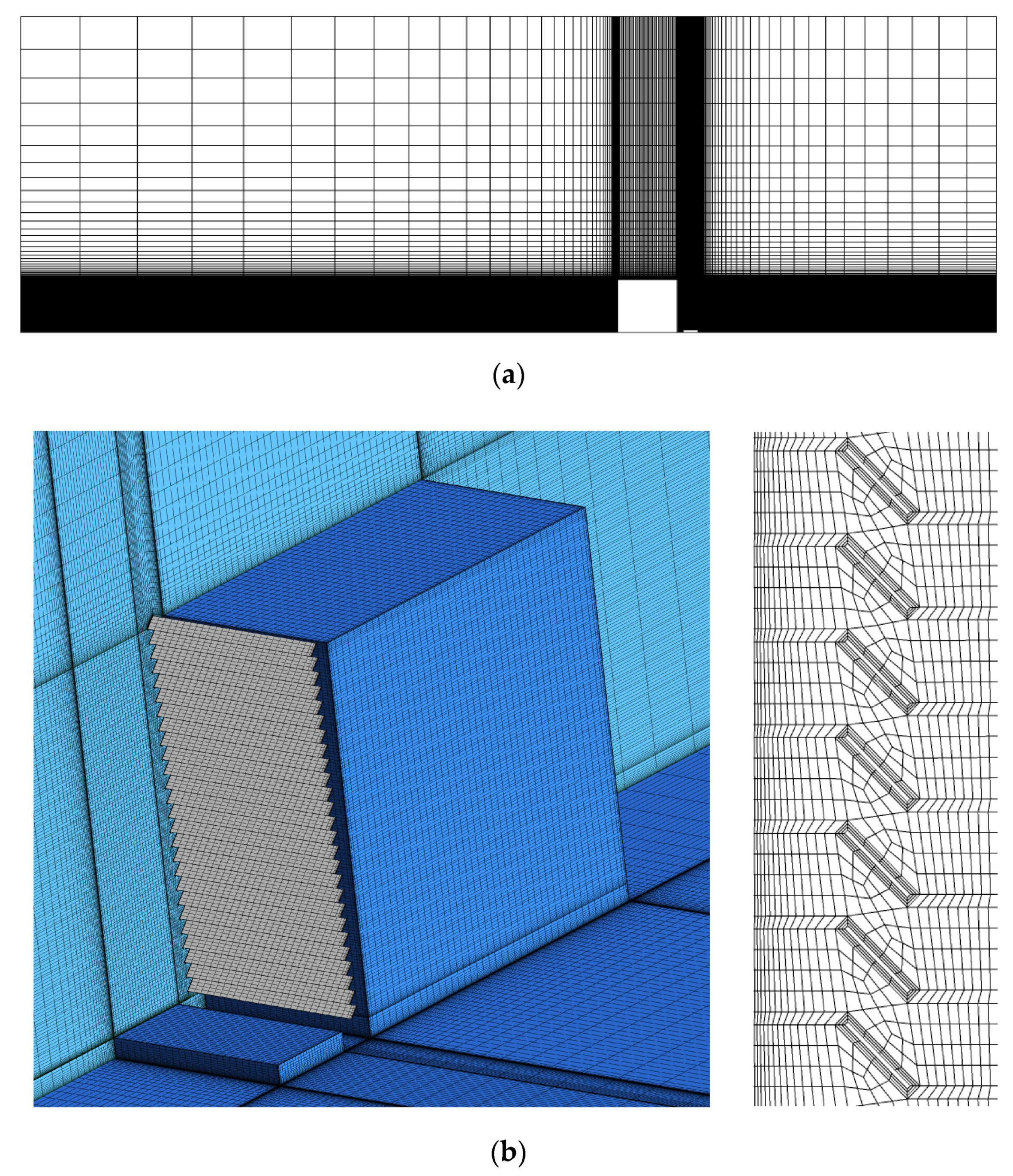

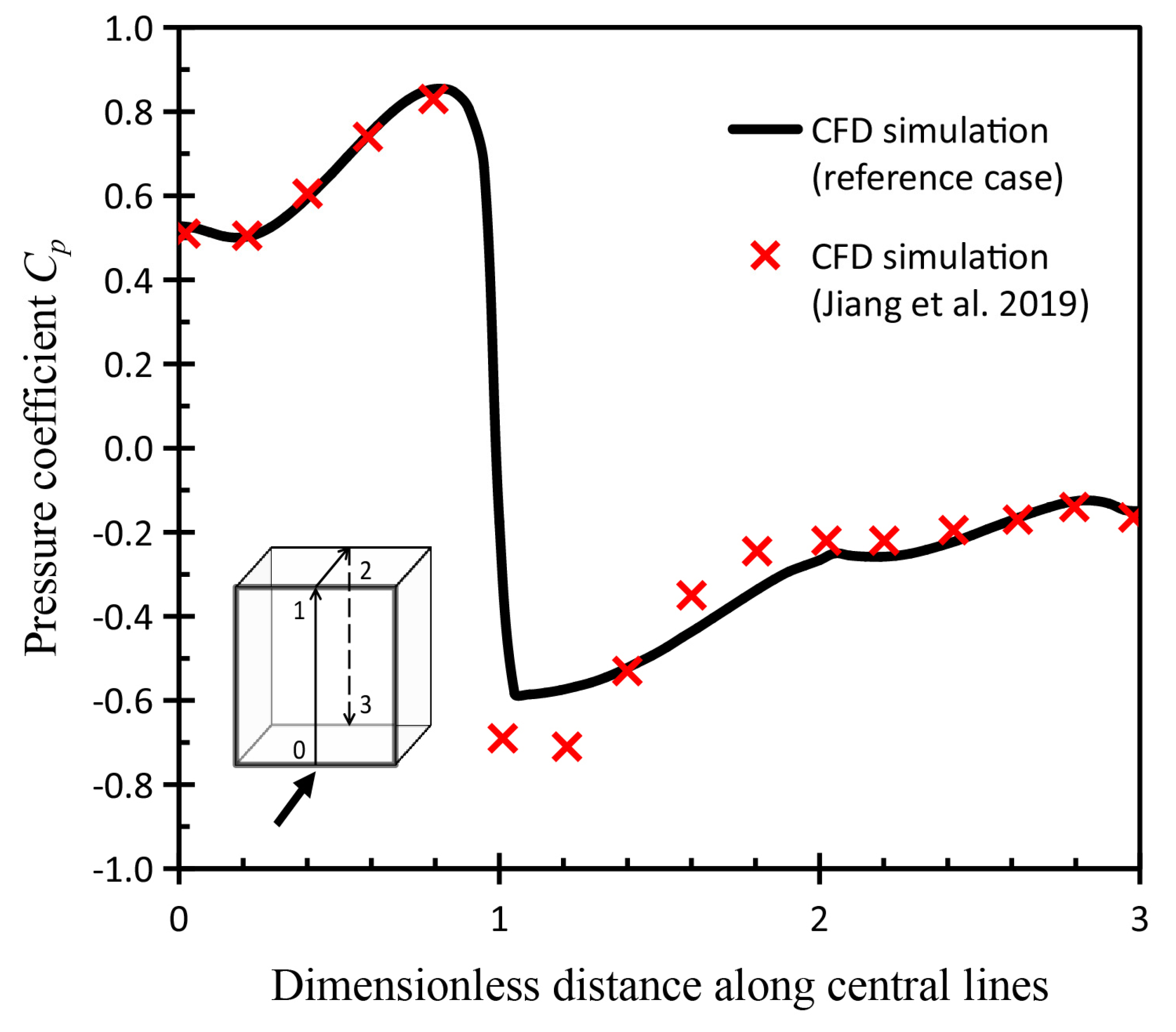
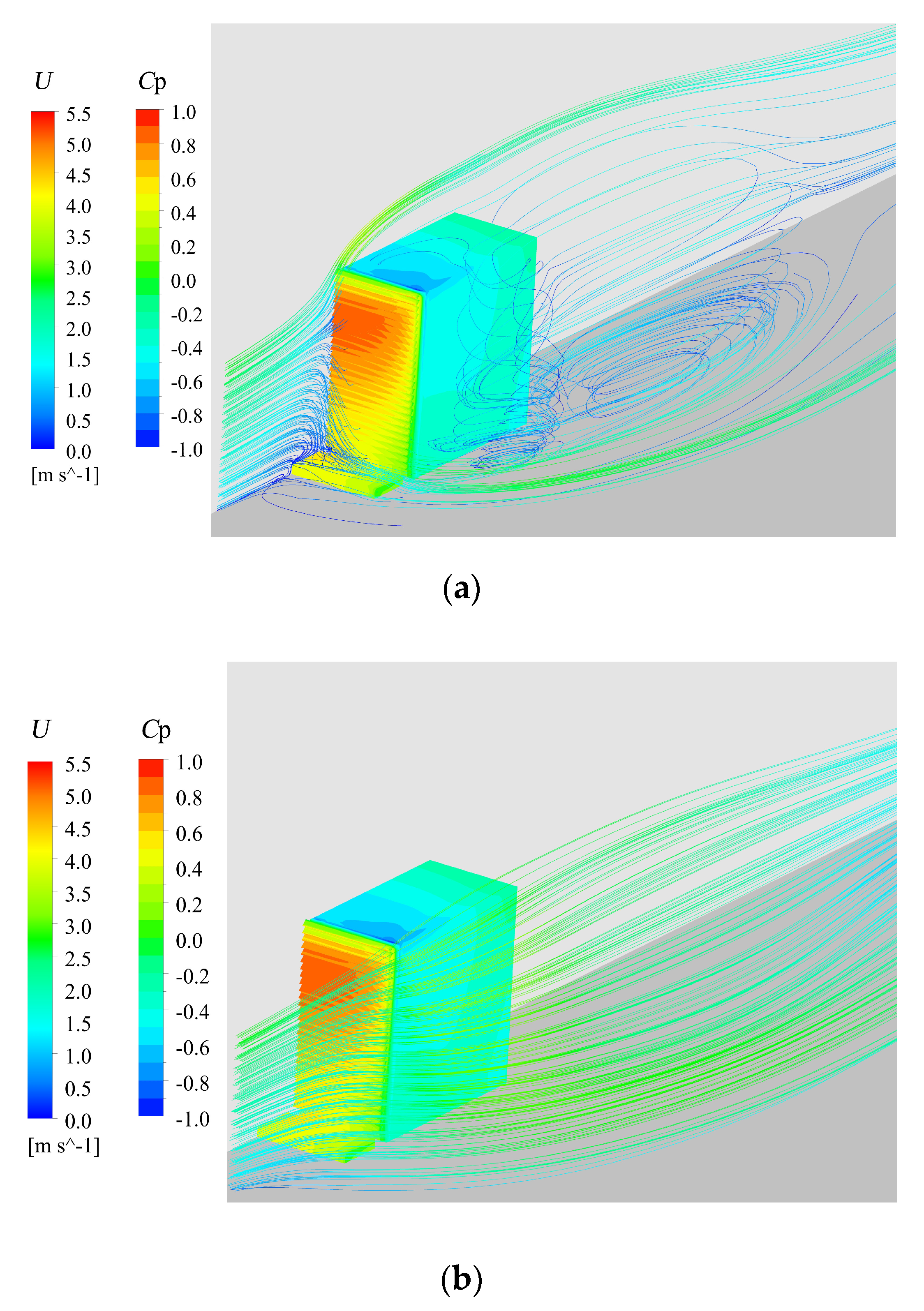
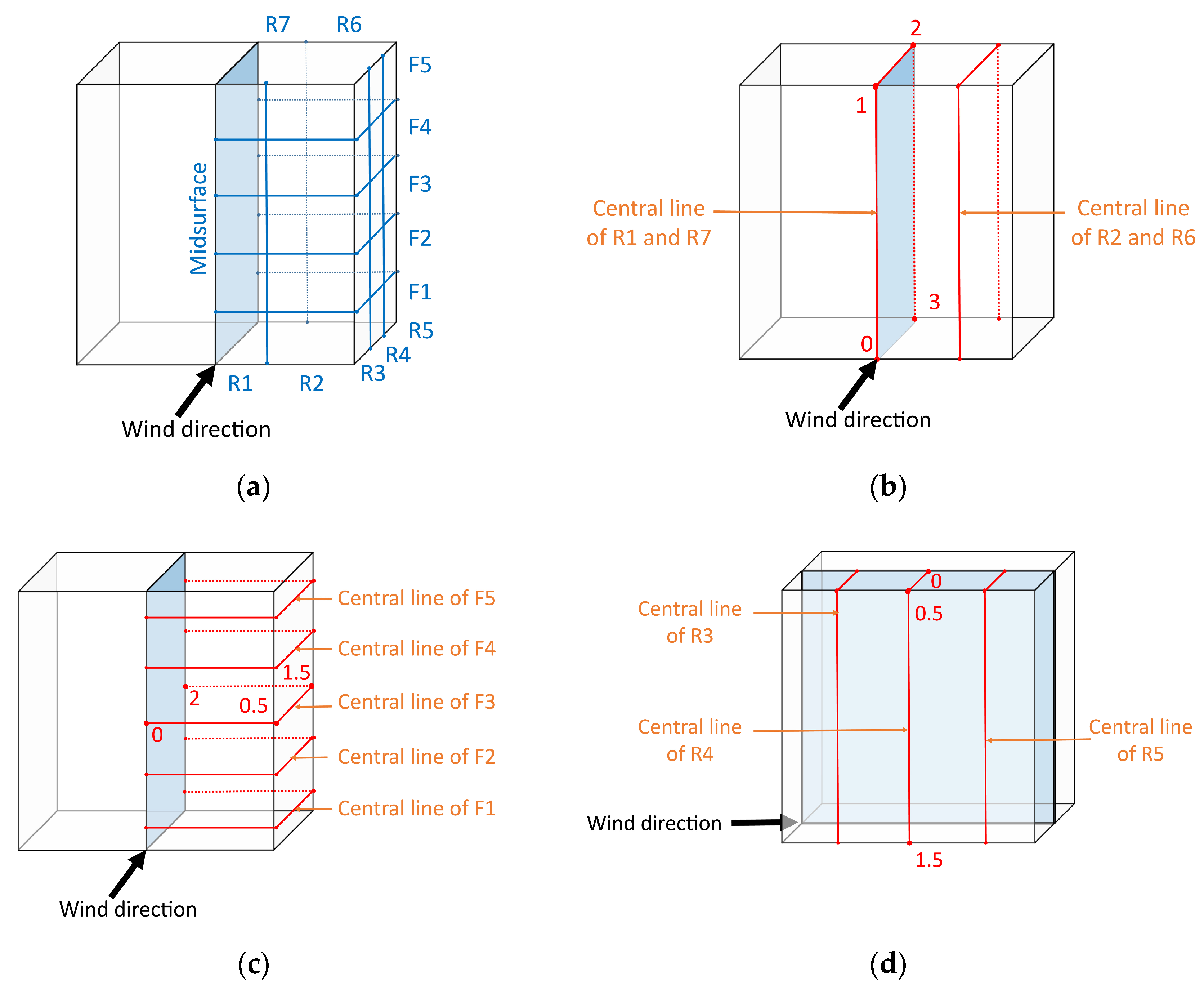
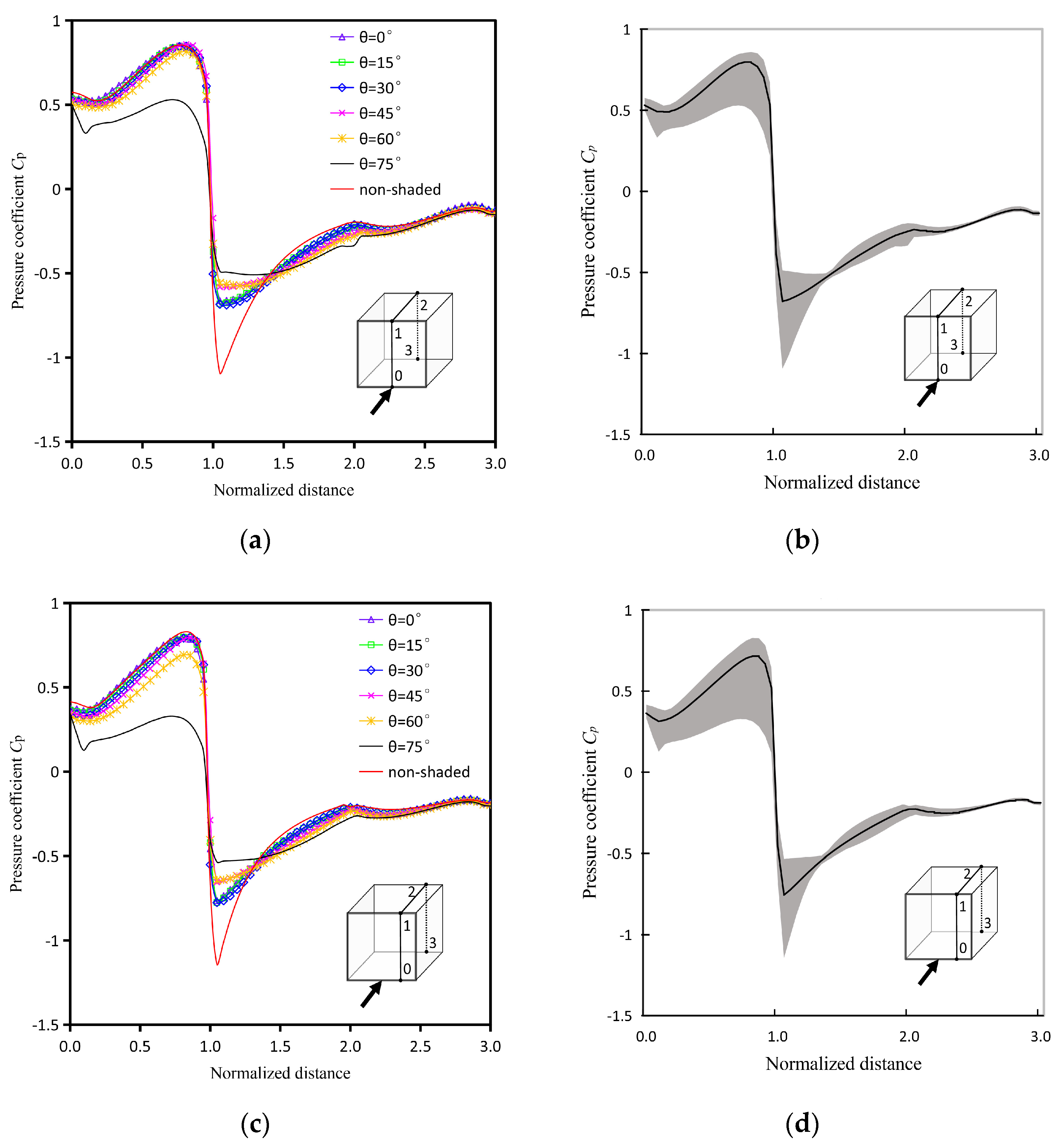
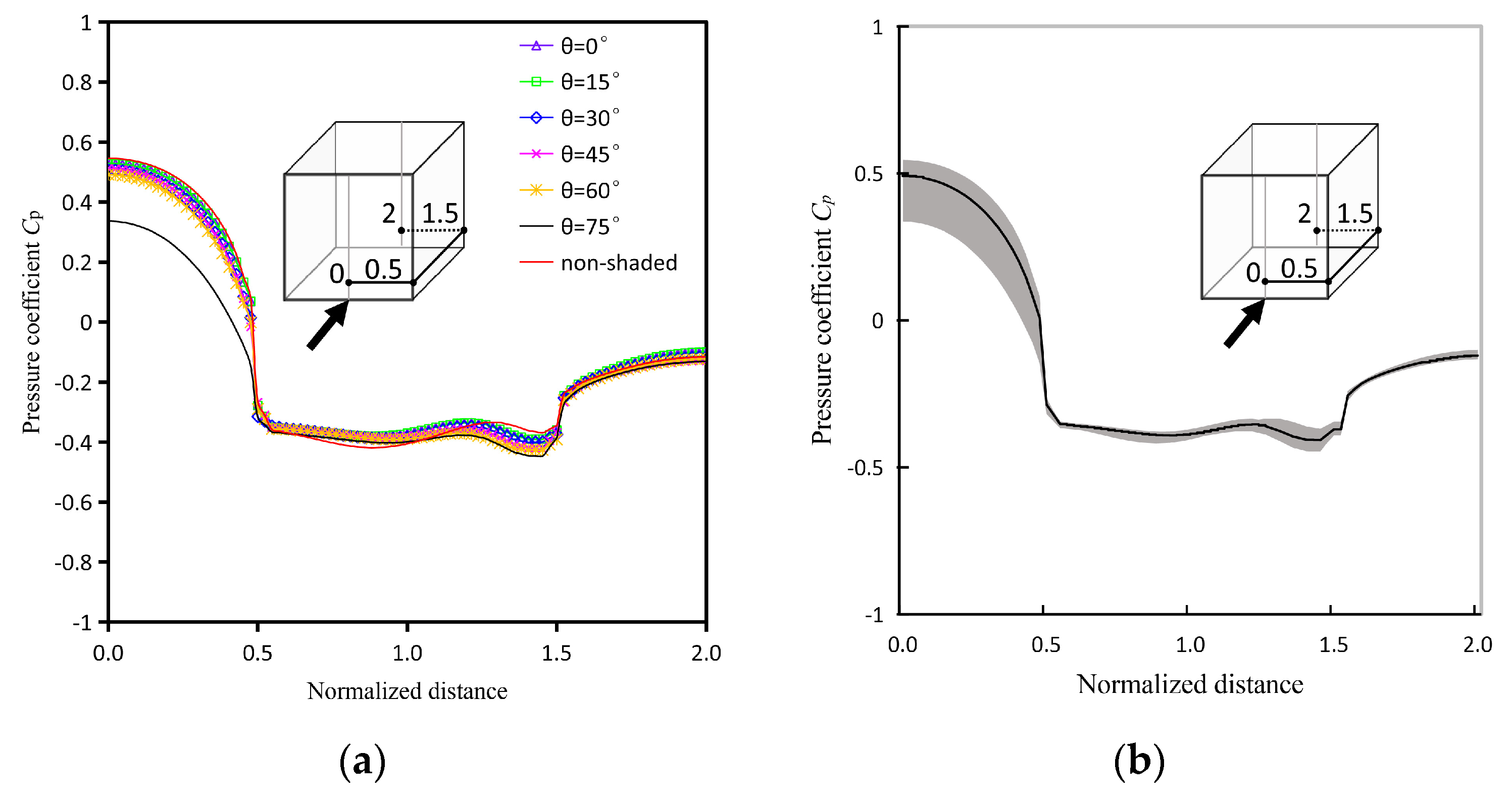
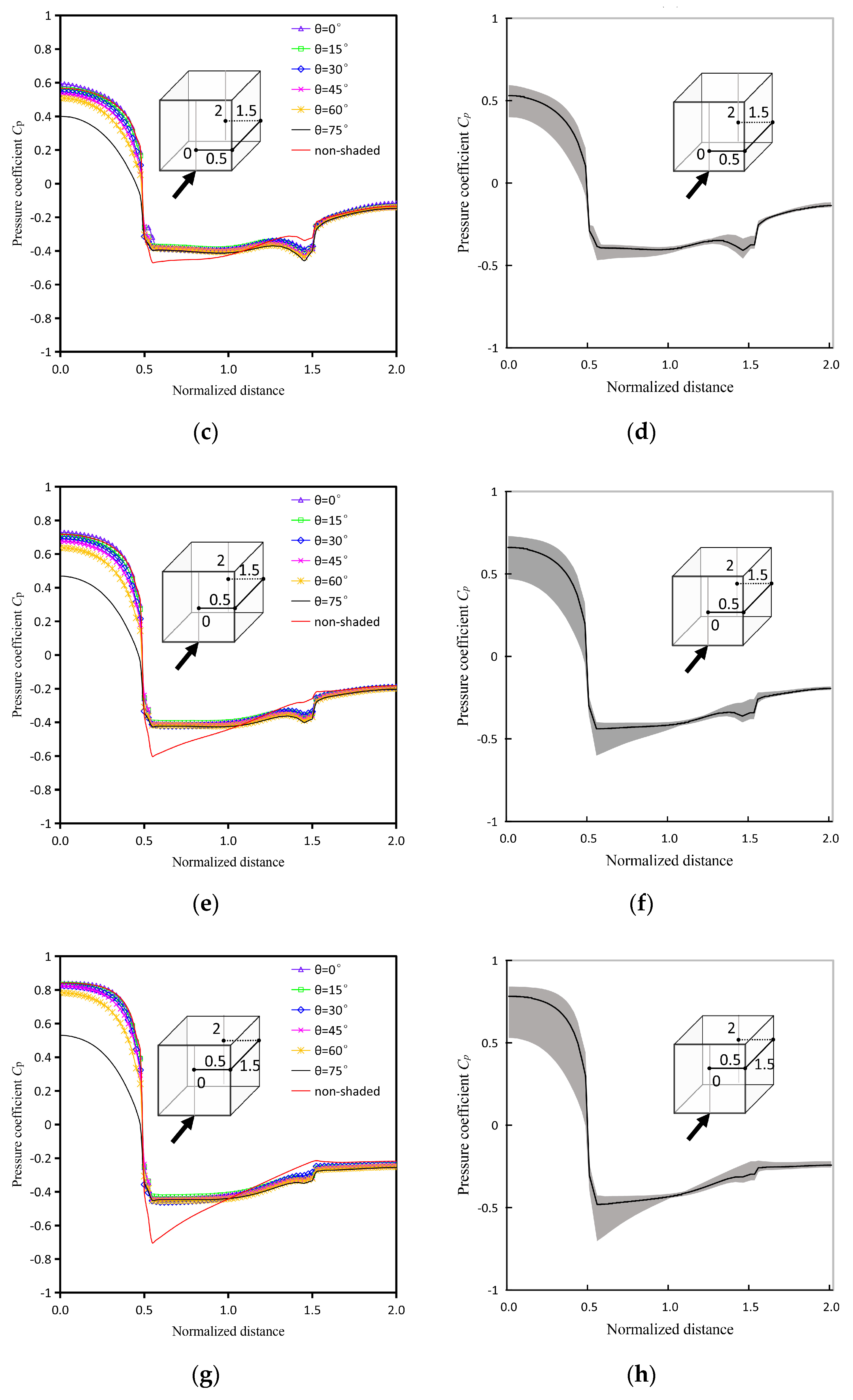
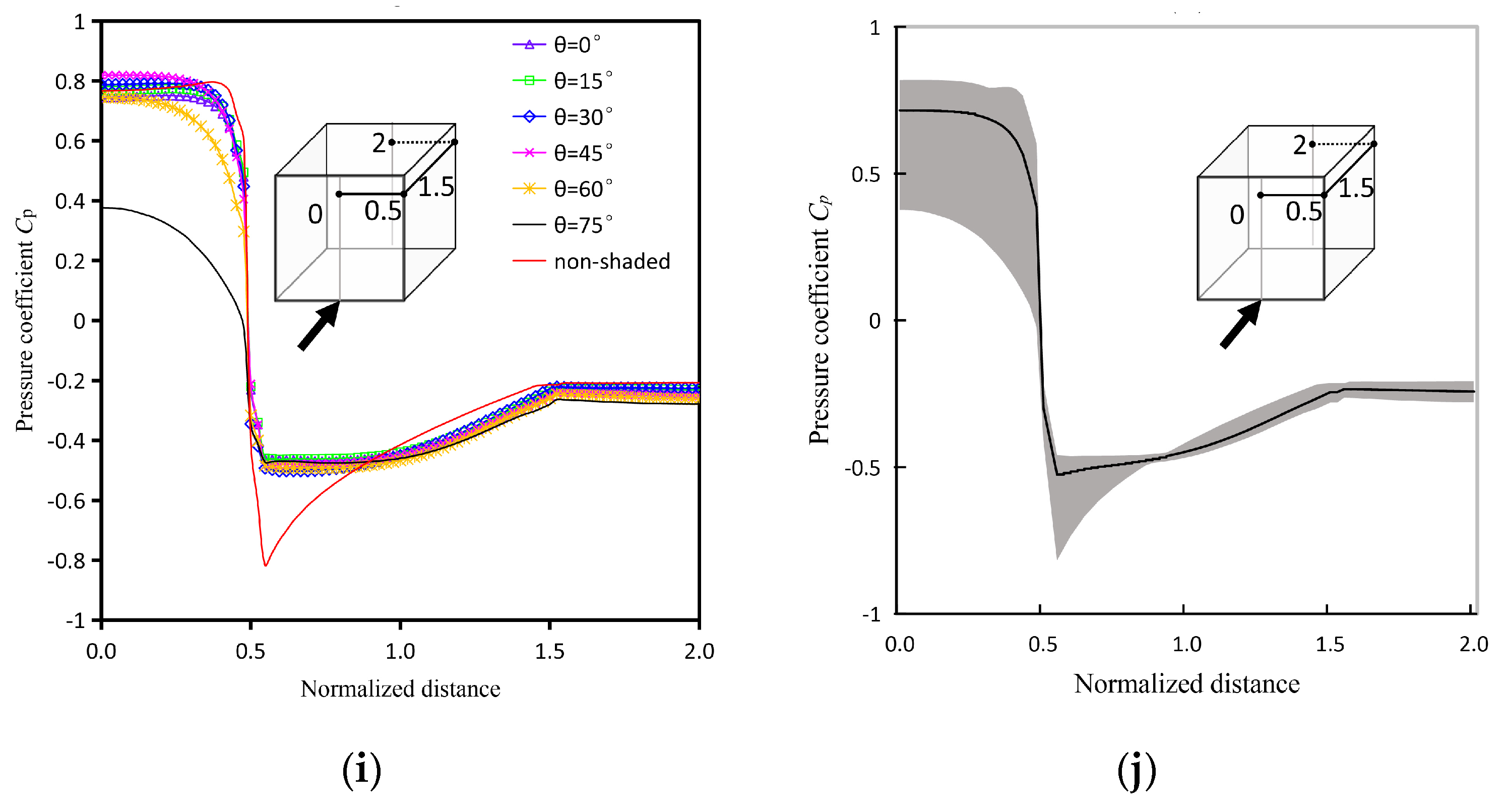
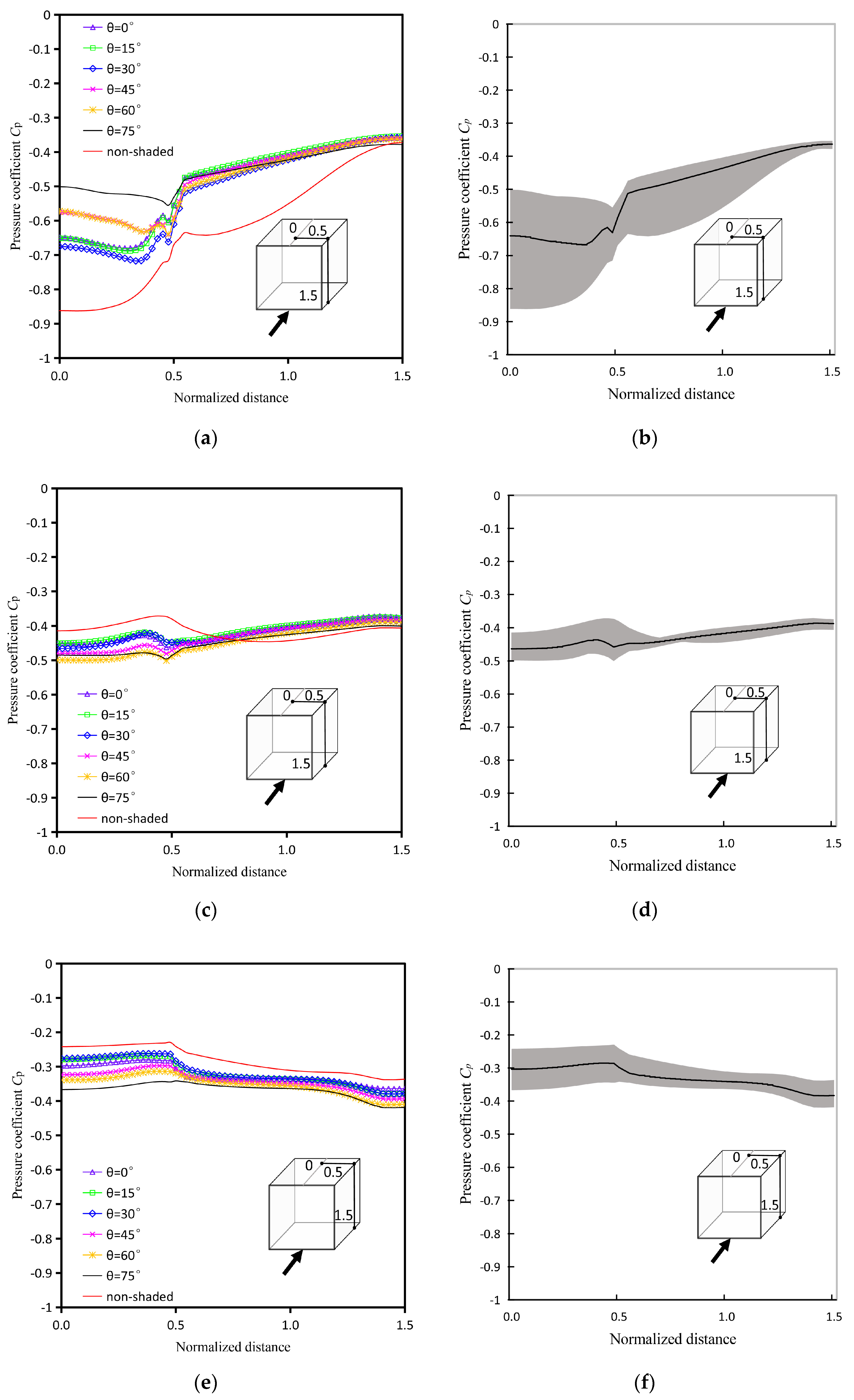
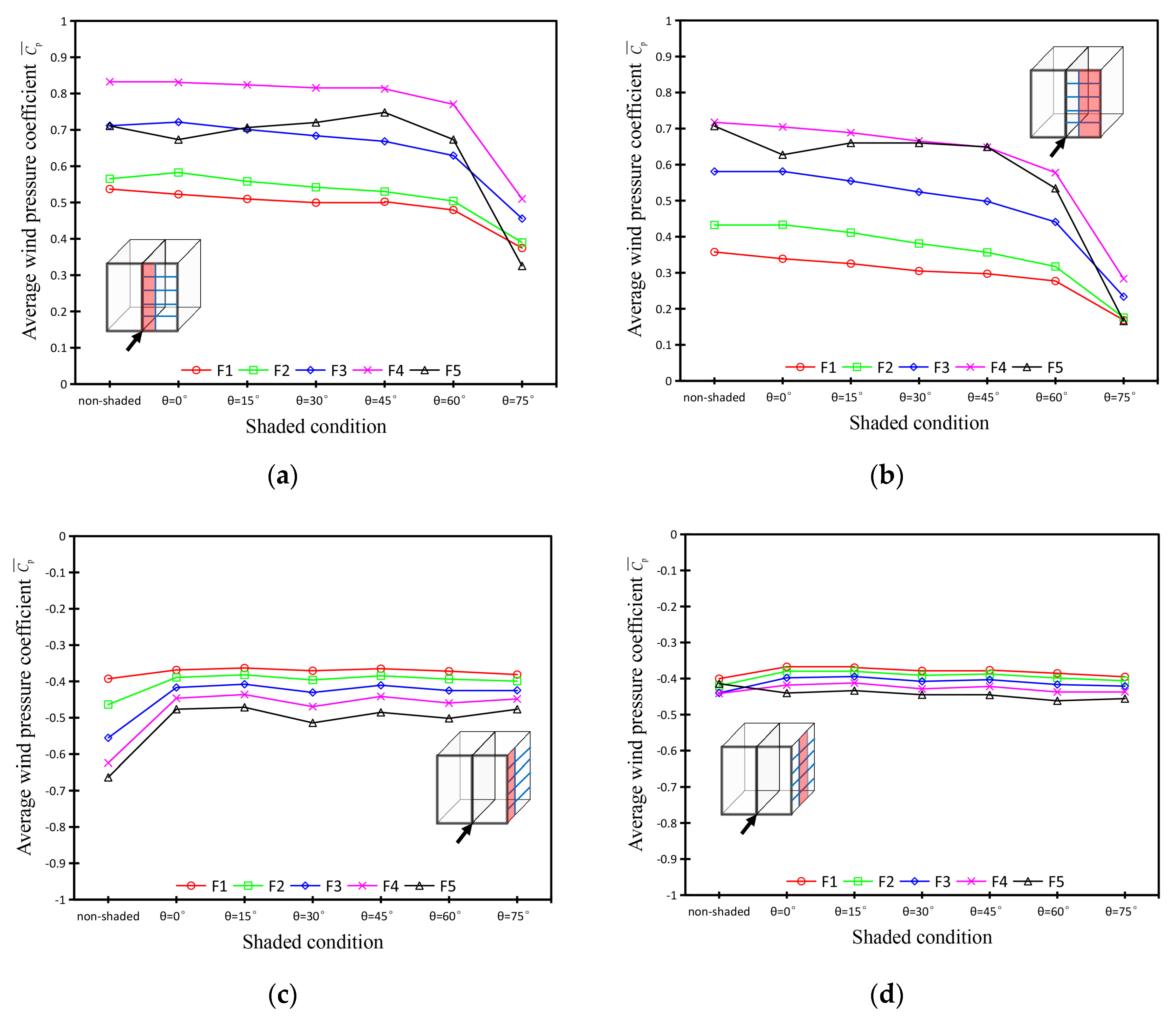
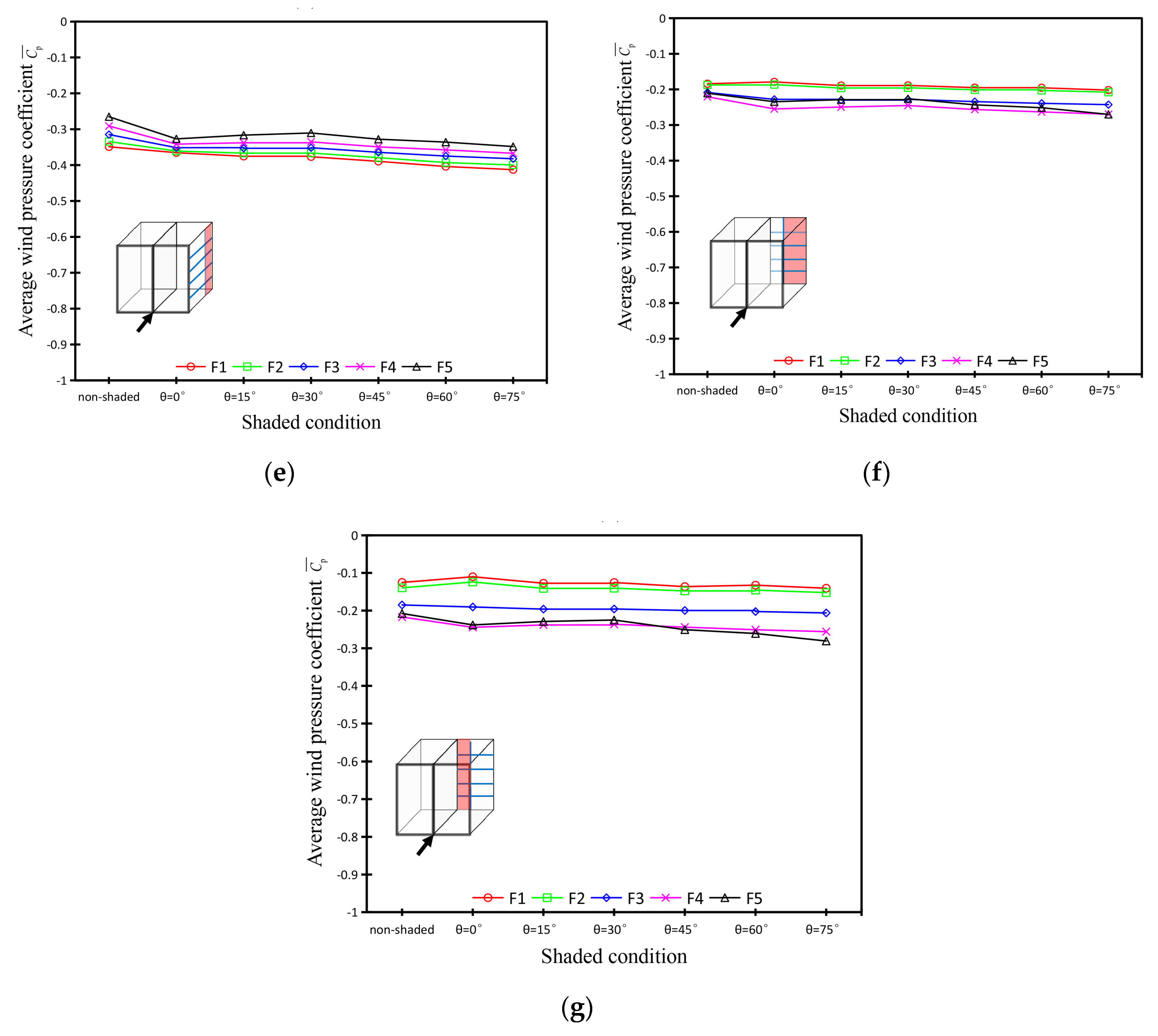

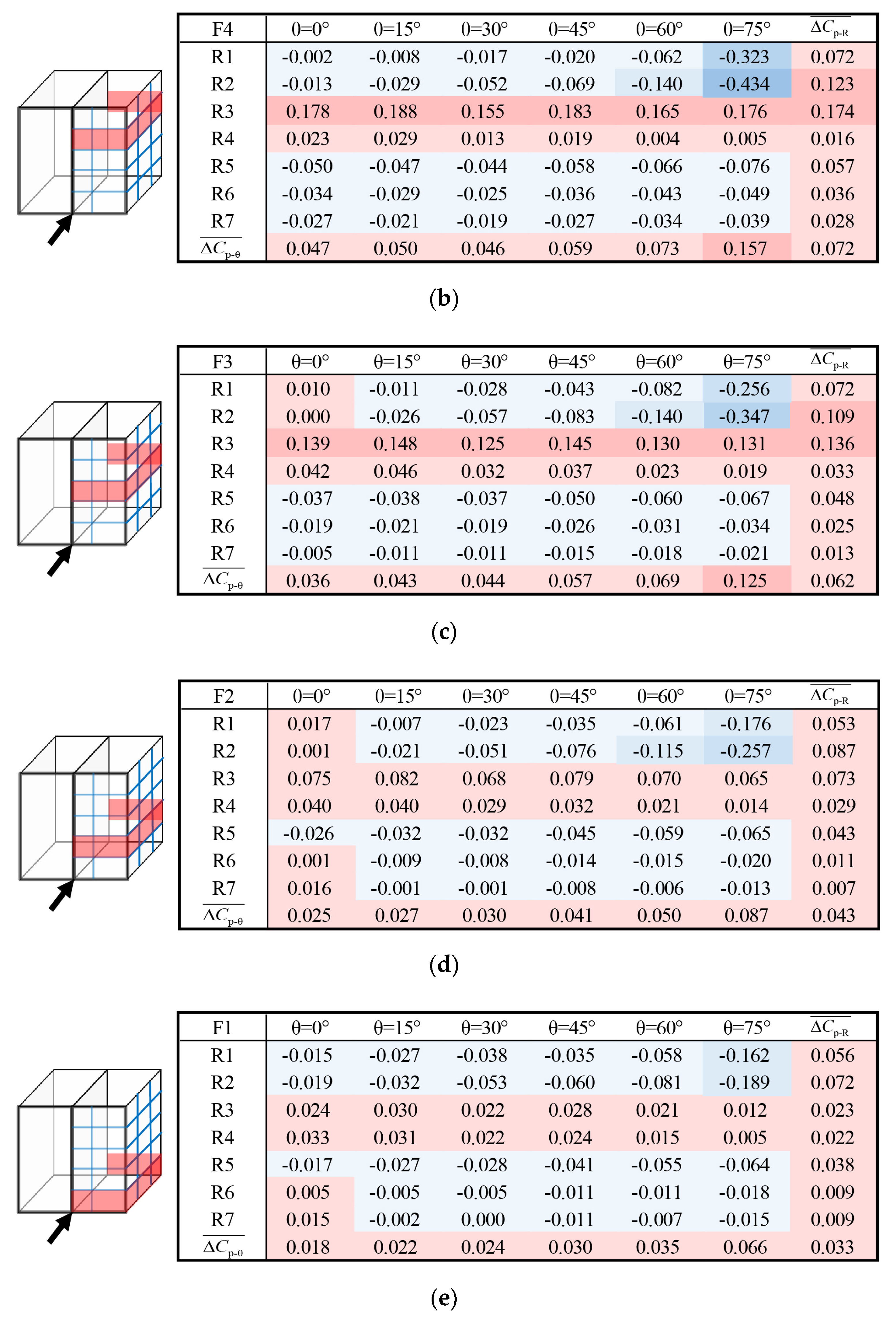
| Value Type | U/Uref | Cp | |||||
|---|---|---|---|---|---|---|---|
| −0.5h0 | 0.5h0 | 1.5h0 | 2.5h0 | Windward | Roof | Leeward | |
| Average value (reference case) | 1.21 | 0.94 | 1.03 | 0.72 | 0.62 | −0.45 | −0.19 |
| Average value (Jiang et al.) | 1.22 | 0.97 | 1.05 | 0.74 | 0.6 | −0.45 | −0.18 |
| Absolute deviation | 0.08 | 0.05 | 0.04 | 0.1 | 0.03 | 0.09 | 0.02 |
© 2020 by the authors. Licensee MDPI, Basel, Switzerland. This article is an open access article distributed under the terms and conditions of the Creative Commons Attribution (CC BY) license (http://creativecommons.org/licenses/by/4.0/).
Share and Cite
Zheng, J.; Tao, Q.; Li, L. Wind Pressure Coefficient on a Multi-Storey Building with External Shading Louvers. Appl. Sci. 2020, 10, 1128. https://doi.org/10.3390/app10031128
Zheng J, Tao Q, Li L. Wind Pressure Coefficient on a Multi-Storey Building with External Shading Louvers. Applied Sciences. 2020; 10(3):1128. https://doi.org/10.3390/app10031128
Chicago/Turabian StyleZheng, Jianwen, Qiuhua Tao, and Li Li. 2020. "Wind Pressure Coefficient on a Multi-Storey Building with External Shading Louvers" Applied Sciences 10, no. 3: 1128. https://doi.org/10.3390/app10031128
APA StyleZheng, J., Tao, Q., & Li, L. (2020). Wind Pressure Coefficient on a Multi-Storey Building with External Shading Louvers. Applied Sciences, 10(3), 1128. https://doi.org/10.3390/app10031128





